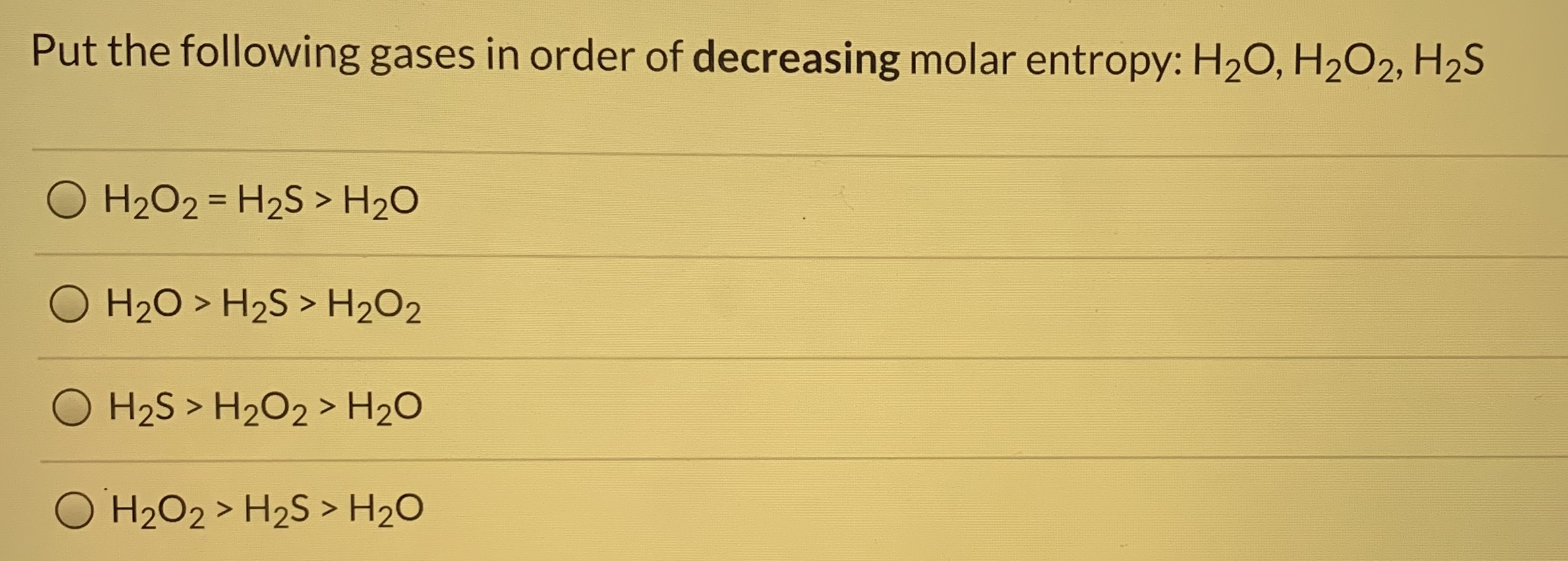
Chemistry
10th Edition
ISBN: 9781305957404
Author: Steven S. Zumdahl, Susan A. Zumdahl, Donald J. DeCoste
Publisher: Cengage Learning
expand_more
expand_more
format_list_bulleted
Question

Transcribed Image Text:Put the following gases in order of decreasing molar entropy: H20, H2O2, H2S
O H2O2 = H2S > H2O
%3D
H20 > H2S > H202
O H2S > H2O2 > H20
O H2O2 > H2S > H2O
Expert Solution
This question has been solved!
Explore an expertly crafted, step-by-step solution for a thorough understanding of key concepts.
This is a popular solution
Trending nowThis is a popular solution!
Step by stepSolved in 4 steps

Knowledge Booster
Similar questions
- What is the entropy change when 1.20 moles of CCl₂F₂ condenses at 25.0 °C? [∆H(vap) = 17.2 kJ/mol at 25.0 °C]?arrow_forwardWhich of the following result in an increase in the entropy of the system? I. H-H II. Br₂(g) → Br₂(7) III. NaBr(s) — Na*(aq) + Br (aq) IV. 02(298 K) → O₂(373 K) V. NH3(1 atm, 298 K) → NH3(3 atm, 298 K) I II, V I, III, IV I, II, III, IV I, II, III, Varrow_forward1. Ammonia can be made from the reaction of nitrogen and hydrogen: N2 (g) + 3 H2 (g) ⟺ 2 NH3 (g) For this reaction, K = 1.6 x 102 and ΔH = -91.8 kcal/mole at 25oC. Is the reaction endothermic or exothermic? Briefly explain. Is there in increase in entropy, a decrease in entropy, or no change in entropy? Briefly explain. At 25oC, is this reaction product favored or reactant favored? Briefly explain. Do you expect this reaction to be spontaneous at all temperatures? Briefly explain.arrow_forward
- Which one has a large entropy? 0.0200 moles of NaBr dissolved in 2.00 L of water or 0.0200 moles of CaCl 2 dissolved in 2.00 L of water. Explainarrow_forwardWhat is the entropy change when 1.90 moles of CHCl3 condenses at 61.0 °C? [AH(vap) = 29.6 kJ/ mol at 61.0 °C]arrow_forward6. Which of the following compounds has the highest entropy at 25°C? A. CO₂ (s) B. CH3CH₂OH (1) C. C₂H6 (g) D. S (s) E. H₂O (1)arrow_forward
- 5. When 2.00 mol of an ideal gas at 330K and 3.50 atm are compressed isothermally to some pressure Pf, its entropy decreases by 25.0 J/K. Calculate Pf and DG for this process.arrow_forwardWhich one of the following choices of gaseous molecules is rank ordered correctly from lowest standard molar entropy (left hand side) to highest standard molar entropy (right hand side)? He, Ne, CO, SiH4 SiH4 , CO, Ne, He SiH4 , Ne, CO, He CO, SiH4 , Ne, Hearrow_forwardgiven rgetable of standard molar entropy values of each substance in the reaction below, what is the standard change in entropy, delta s, for the following reaction? 2CH3OH(g)+3OH2- 2CO2(g)+4H2O(g) Substance= CH3OH(g) S(J/mol•K) 240 Substance=O2(g) S(J/mol•K) 205 Substance=CO2(g) S(J/mol•K) 214 Substance=H2O(g) S(J/mol•k) 189 a. -352 J/K b. -1302 J/K c. 315 J/K d. 89 J/K E. 1830 J/Karrow_forward
- Which one of the systems would have more entropy and why if there's 3 particles w a total energy of 12 Jarrow_forwardouming Calculate the standard molar entropy of vaporization of water at 43.0 °C, given that its standard molar entropy of vaporization at 100.0 °C is 109.0 J-K mol and the molar heat capacities at constant pressure for liquid water and water vapor are 75.3 J-K1.mol-1 and 33.6 J-K.mol, respectively, in this temperature range. J.K-1. mol-1 ASvap TOOLS x10 Question Source: Atkins 7e - Chemical Principles | Publisher: W.H. Fm We Thearrow_forwardWhat is the entropy when 1.13 moles of CCl₂F₂ vaporize at 25°C? [∆H(vap) = 17.2 kJ/mol at 25°C]arrow_forward
arrow_back_ios
arrow_forward_ios
Recommended textbooks for you
 ChemistryChemistryISBN:9781305957404Author:Steven S. Zumdahl, Susan A. Zumdahl, Donald J. DeCostePublisher:Cengage Learning
ChemistryChemistryISBN:9781305957404Author:Steven S. Zumdahl, Susan A. Zumdahl, Donald J. DeCostePublisher:Cengage Learning ChemistryChemistryISBN:9781259911156Author:Raymond Chang Dr., Jason Overby ProfessorPublisher:McGraw-Hill Education
ChemistryChemistryISBN:9781259911156Author:Raymond Chang Dr., Jason Overby ProfessorPublisher:McGraw-Hill Education Principles of Instrumental AnalysisChemistryISBN:9781305577213Author:Douglas A. Skoog, F. James Holler, Stanley R. CrouchPublisher:Cengage Learning
Principles of Instrumental AnalysisChemistryISBN:9781305577213Author:Douglas A. Skoog, F. James Holler, Stanley R. CrouchPublisher:Cengage Learning Organic ChemistryChemistryISBN:9780078021558Author:Janice Gorzynski Smith Dr.Publisher:McGraw-Hill Education
Organic ChemistryChemistryISBN:9780078021558Author:Janice Gorzynski Smith Dr.Publisher:McGraw-Hill Education Chemistry: Principles and ReactionsChemistryISBN:9781305079373Author:William L. Masterton, Cecile N. HurleyPublisher:Cengage Learning
Chemistry: Principles and ReactionsChemistryISBN:9781305079373Author:William L. Masterton, Cecile N. HurleyPublisher:Cengage Learning Elementary Principles of Chemical Processes, Bind...ChemistryISBN:9781118431221Author:Richard M. Felder, Ronald W. Rousseau, Lisa G. BullardPublisher:WILEY
Elementary Principles of Chemical Processes, Bind...ChemistryISBN:9781118431221Author:Richard M. Felder, Ronald W. Rousseau, Lisa G. BullardPublisher:WILEY

Chemistry
Chemistry
ISBN:9781305957404
Author:Steven S. Zumdahl, Susan A. Zumdahl, Donald J. DeCoste
Publisher:Cengage Learning

Chemistry
Chemistry
ISBN:9781259911156
Author:Raymond Chang Dr., Jason Overby Professor
Publisher:McGraw-Hill Education

Principles of Instrumental Analysis
Chemistry
ISBN:9781305577213
Author:Douglas A. Skoog, F. James Holler, Stanley R. Crouch
Publisher:Cengage Learning

Organic Chemistry
Chemistry
ISBN:9780078021558
Author:Janice Gorzynski Smith Dr.
Publisher:McGraw-Hill Education

Chemistry: Principles and Reactions
Chemistry
ISBN:9781305079373
Author:William L. Masterton, Cecile N. Hurley
Publisher:Cengage Learning

Elementary Principles of Chemical Processes, Bind...
Chemistry
ISBN:9781118431221
Author:Richard M. Felder, Ronald W. Rousseau, Lisa G. Bullard
Publisher:WILEY